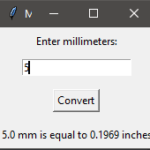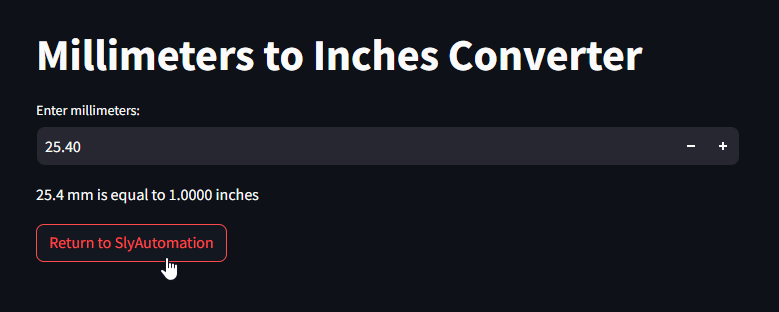Millimeters to Inches Converter
When it comes to unit conversions, Python can convert mm to inches with ease and in a user friendly way, offering a powerful toolset to simplify the process. In this tutorial, we’ll delve into creating a user-friendly GUI application that converts mm to inches using the Tkinter library. By the end, you’ll have a fully functional tool at your disposal.
The Python Script: coding mm to inches
In the realm of GUI development, Tkinter stands out as a versatile library. We’ll leverage its capabilities to create an intuitive interface for our millimeters to inches converter. Here’s a breakdown of the key components for mm to inches:
1. Importing the Necessary Libraries
import tkinter as tkWe kick off by importing the tkinter library, which provides the building blocks for our graphical user interface that will incorporate the mm to inches.
2. Defining the Conversion Logic for mm to inches app
def convert():
try:
mm_value = float(entry_mm.get())
inches_value = mm_value / 25.4
label_result.config(text=f'{mm_value} mm is equal to {inches_value:.4f} inches')
except ValueError:
label_result.config(text='Invalid input. Please enter a numeric value.')The convert function encapsulates our conversion logic. It extracts the millimeter value from the user input, performs the conversion, and updates the result label. Robust error handling ensures a smooth user experience and prevent errors when calculating mm to inches.
Let’s break down each line of the code:
try:
- The
tryblock is used to enclose a section of code that might raise an exception (an error). In this case, it’s used to catch aValueErrorif the user enters a non-numeric value.
mm_value = float(entry_mm.get())
entry_mm.get()retrieves the text entered by the user in the Tkinter Entry widget (entry_mm).float()converts this text to a floating-point number. This line stores the millimeter value entered by the user in the variablemm_value.
inches_value = mm_value / 25.4
- This line calculates the equivalent inches value by dividing the millimeter value (
mm_value) by the conversion factor 25.4. The result is stored in the variableinches_value.
label_result.config(text=f'{mm_value} mm is equal to {inches_value:.4f} inches')
- This line updates the text of the
label_resultlabel widget with the result of the conversion. It uses an f-string to format the text dynamically, incorporating the original millimeter value (mm_value) and the calculated inches value (inches_value). The:.4fspecifies that the inches value should be displayed with four decimal places.
except ValueError:
- The
exceptblock catches a specific exception, in this case,ValueError. If the conversion to a float in line 2 fails (e.g., because the user entered a non-numeric value), the code within theexceptblock will be executed.
label_result.config(text='Invalid input. Please enter a numeric value.')
- Inside the
exceptblock, this line updates the text of thelabel_resultlabel widget to indicate that the user provided an invalid input. Specifically, it prompts the user to enter a numeric value.
In summary, these lines of code handle the conversion of millimeters to inches and update the GUI with the result or an error message, ensuring a smooth user experience and robust error handling.
3. Creating the GUI Components
window = tk.Tk()
window.title('MM to Inches Converter')
label_mm = tk.Label(window, text='Enter millimeters:')
entry_mm = tk.Entry(window)
convert_button = tk.Button(window, text='Convert', command=convert)
label_result = tk.Label(window, text='')Here, we set up the main window, labels, entry field, button, and a result label. These elements form the foundation of our user-friendly interface for mm to inches.
4. Running the Application
window.mainloop()Finally, the mainloop function keeps our GUI application running, allowing users to interact with it seamlessly.
Here’s what the mm to inches tkinter app looks like:

The Conversion Process: Simplified and Accurate
The conversion itself is straightforward. Upon entering a millimeter value and clicking the “Convert” button, our Python script performs the necessary calculations. The result is displayed with precision, making it an effective tool for various applications that use mm to inches.
Why Choose Python for Unit Conversions?
- Ease of Use: Python’s syntax is clear and concise, making it accessible for both beginners and experienced developers.
- Versatility: Python’s extensive libraries, like Tkinter, empower developers to create feature-rich applications without unnecessary complexity.
- Community Support: Python boasts a robust community that provides ample resources and assistance, making problem-solving a collaborative effort.
mm to inches Python Web App using Streamlit!

To create a Python Streamlit app for the millimeters to inches converter, you can use the following code. Make sure you have Streamlit installed before running the script:
pip install streamlitHere’s the Streamlit app code:
import streamlit as st
def mm_to_inches_converter(mm_value):
try:
inches_value = mm_value / 25.4
return inches_value
except ValueError:
return "Invalid input. Please enter a numeric value."
def main():
st.title("Millimeters to Inches Converter")
# Get user input for millimeter value
mm_value = st.number_input("Enter millimeters:", min_value=0.0, step=1.0)
# Convert millimeters to inches
inches_result = mm_to_inches_converter(mm_value)
# Display result
st.write(f"{mm_value} mm is equal to {inches_result:.4f} inches")
if __name__ == "__main__":
main()To run the Streamlit app, save the code in a file (e.g., streamlit_mm_to_inches_converter.py) and execute the following command in your terminal:
streamlit run streamlit_mm_to_inches_converter.pyThis will start a local server, and you can view the app in your web browser by visiting the provided URL.
Explanation of key parts:
st.title("Millimeters to Inches Converter"): Sets the title of the Streamlit app.st.number_input("Enter millimeters:", min_value=0.0, step=1.0): Creates an input widget for the user to enter millimeter values.mm_to_inches_converter(mm_value): Function to perform the conversion from millimeters to inches.st.write(f"{mm_value} mm is equal to {inches_result:.4f} inches"): Displays the result of the conversion.
Streamlit automatically handles the user interface, and this app provides a simple and interactive way to convert millimeters to inches.



Conclusion: Unlocking Efficiency with Python
In this tutorial, we’ve explored the creation of a millimeters to inches converter using Python’s Tkinter library and another using the streamlit webapp solution. The script’s simplicity and efficiency make it a valuable tool for anyone needing quick and accurate unit conversions.
Whether you’re a Python novice or a seasoned developer, this tutorial provides a solid foundation for understanding GUI development and unit conversion in Python. Harness the power of Python to create customized solutions for your projects.
By combining practical coding examples with clear explanations, this tutorial equips you with the knowledge to seamlessly implement a millimeters to inches converter in Python. Start coding and elevate your understanding of GUI and Web applications and unit conversions today.
Need more python app ideas? Check out: Youtube to mp3 code or dice roller app









